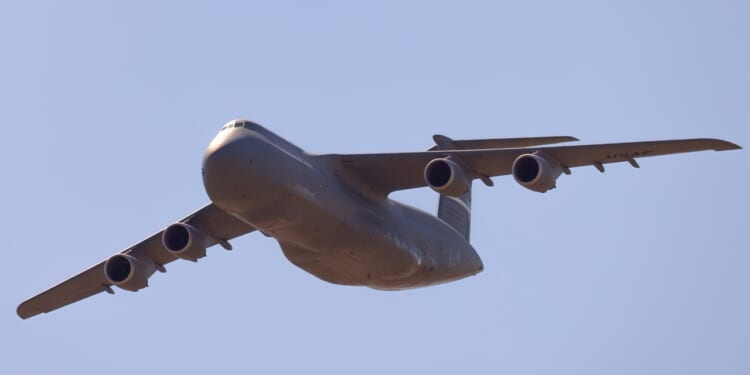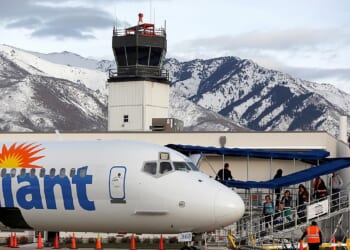The Air Force is preparing for the Next Generation Airlifter (NGAL) to replace both aircraft, though it is still around 20 years from active service.
The US Air Force plans to replace both of its strategic airlift platforms, the C-17 Globemaster III and the C-5M Galaxy, with a single platform, the Next Generation Airlifter (NGAL), sometime in the mid-2040s. The NGAL aims to merge the capabilities of the Air Force’s two existing strategic airlift platforms into one, with greater speed, agility, survivability, advanced countermeasures, and rapid ground turnaround. The new concept is being designed following the now dominant trends in US military aircraft design: role consolidation in a single platform, and survivability against near-peer adversaries.
Saying Goodbye to the C-5 Galaxy and the C-17 Globemaster III
For decades, American global power projection has relied deeply upon two massive aircraft, the C-17 and the C-5. Both aircraft are essential to the uncommonly ambitious foreign policy of the United States, which aims to sustain a physical presence across oceans and continents—a presence that would be impossible without capable strategic airlift platforms, who can ferry tanks, helicopters, and troops around the world.
| Aircraft | C-5 Galaxy | C-17 Globemaster III |
| Manufacturer | Lockheed (Lockheed Martin) | McDonnell Douglas / Boeing |
| Year Introduced | 1969 (C-5M upgrade program completed 2018) | 1995 |
| Number Built | 131 total (~52 active today) | 279 (total; US operates 222) |
| Length | 247 ft (75.3 m) | 174 ft (53 m) |
| Wingspan | 222 ft 9 in (68 m) | 170 ft (51.8 m) |
| Weight (MTOW) | 840,000 lb (381,000 kg) | 585,000 lb (265,350 kg) |
| Engines | Four General Electric CF6-80C2 (F138-GE-100) turbofans (~51,250 lbf thrust each | Four Pratt & Whitney F117-PW-100 turbofans (~40,440 lbf thrust each) |
| Top Speed | ~450 knots (520 mph, 837 km/h) | ~450 knots (520 mph, 837 km/h) |
| Range | ~4,800 nmi (5,520 mi, 8,900 km) with payload | 2,420 nmi (2,780 mi, 4,482 km) |
| Service Ceiling | ~35,000 ft (10,660 m) at max weight | ~45,000 ft (13,700 m) |
| Cargo Loadout | 281,000 lb (127,460 kg) max payload; can carry outsized cargo (satellites, helicopters, tanks); unique nose and tail doors allow simultaneous loading | 170,900 lb (77,500 kg) max payload; can carry M1 Abrams tank, armored vehicles, helicopters, or 102 paratroopers |
| Aircrew | 7 | 3 |
The C-17 entered service in 1995 and is the most versatile airlifted in the US inventory. With a payload capacity of roughly 82 tons, the C-17 can heft main battle tanks, armored vehicles, or large troop contingents at 520 miles per hour. More impressive still, the C-17 can operate in places other heavy lifters cannot—from short, rough, austere airstrips; the C-17 can land on dirt and gravel, transporting the equipment necessary to conduct global operations. The C-17 can also drop paratroopers from the sky, delivering manpower directly into hot zones. For three decades, the C-17 has been a cornerstone of both strategic and tactical lift operations.
The C-5, by contrast, is the largest airlift platform in the US inventory, the crux of strategic airlift capabilities. Unmatched in sheer carrying capacity, the C-5 can heft up to 135 tons of cargo including oversized loads that no other aircraft can move. The C-5’s interior is cavernous—large enough to store satellites, engineering equipment, and formations of vehicles. Notably, the C-5 can open from both the nose and tail simultaneously, allowing loading from both ends, which dramatically speeds up ground operations. While less versatile or agile than the C-17, the C-5 is the only option when you just need something huge.
But both platforms are aging, forcing the Air Force to begin contemplating a successor: the Next Generation Airlifter (NGAL).
Introducing the NGAL Cargo Plane
The Air Force is nowhere near fielding the NGAL, a two-for-one platform, still likely at least 20 years from entering service. Finishing the NGAL as planned will require some ingenious engineering—the consolidation of the missions of both the C-17 and C-5 into a single aircraft. Such design requirements reflect the anticipated future of war, where platforms are increasingly vulnerable to increasingly sophisticated air defense networks. Accordingly, the NGAL will need to feature robust defensive systems capable of defeating long-range surface-to-air missiles and drone swarms. On the ground, the NGAL must minimize vulnerability by cutting turnaround times, refueling in minutes, loading and unloading faster, and generally avoiding sitting around on foreign tarmacs.
Accordingly, the designers have a monumental task ahead: combining the raw lifting capacity of the C-5 with the rugged versatility of the C-17—in a package that can survive against modern adversaries like Russia or China.
About the Author: Harrison Kass
Harrison Kass is a senior defense and national security writer at The National Interest. Kass is an attorney and former political candidate who joined the US Air Force as a pilot trainee before being medically discharged. He focuses on military strategy, aerospace, and global security affairs. He holds a JD from the University of Oregon and a master’s in Global Journalism and International Relations from NYU.
Image: Shutterstock / ranchorunner.

















